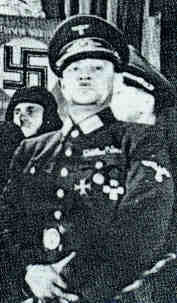
Erich Koch
1896-1986
Photo courtesy of R. James Bender.
Hitler appointed the Nazi philosopher Alfred Rosenberg (1893-1946) head of the Ostministerium (East Ministry) in charge of administering the territory of Ukraine. Before the war Rosenberg was pro-Ukrainian and anti-Muscovite (Russian). He planned to establish a Greater Ukraine state taking territory from Western Russia. However, Hitler had a different idea. He thought Ukrainians should get no preferential treatment and personally appointed Erich Koch to rule Reichskommissariat Ukraine (eastern Ukraine) with an iron fist.
Koch, as a member of the superior German Herrenvolk master race, started a reign of terror and oppression in Ukraine. Koch often said that the Ukrainian people were inferior to the Germans, that Ukrainians were half-monkeys, and that Ukrainians "must be handled with the whip like the negroes." He once said that "no German soldiers would die for these niggers [Ukrainians]."
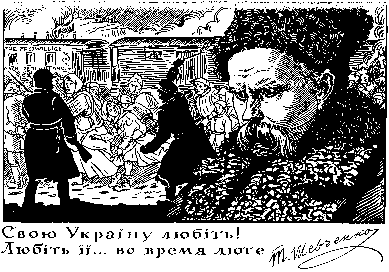
A 1942 war poster by Vasyl Kasiyan of Ukrainians being taken as slave laborers to Germany under German whips and armed German soldiers. "Love your Ukraine!" says the poet Taras Shevchenko (1814-61).
During the first year of the war Koch encouraged the use of whips on Ukrainians. "In November 1942 about twenty Ukrainians were whipped by the police because they sabotaged important bridge construction across the Dnieper. I knew nothing of this measure. Had I known ... I probably would have had these Ukrainians shot for sabotage." - Erich Koch, March 13, 1943 (Dallin p. 157). On April 18, 1942 Koch finally banned the use of the whip on Ukrainians, Koch's brutality towards Ukrainians was approved by Hitler, Goering, Bormann, Sauckel and Himmler. However Rosenberg and Goebbels did not approve of his methods. Although Rosenberg was the superior of Koch he was too weak to control Koch and Rosenberg's pro-Ukrainian plans were shelved very early in the war.
Hitler was intent on destroying education and culture in Ukraine. During a visit to Ukraine in 1942 Hitler said Ukrainians "should be given only the crudest kind of education necessary for communication between them and their German masters." Erich Koch ordered: "I expect the General Commissars to close all schools and colleges with students over 15 years of age and send all teachers and students, irrespective of sex, in a body to Germany for work.... I require that no school except four-grade elementary schools should function." All schools above grade four were closed in January 1942 and also all universities were closed as well.
Like Bormann and Goering, SS leader Heinrich Himmler said that "the entire Ukrainian intelligentsia must be decimated." (Dallin, p. 127).
Reichskommissar Erich Koch, a cruel and vicious German who called himself "a brutal dog," once said "If I find a Ukrainian who is worthy of sitting at the same table with me, I must have him shot." He condemned Kiev to a slow death by famine and made his "capital" Rivne which was a small town of 40,000 about 200 miles west of Kiev.
Koch was ordered to provide 450,000 workers a year from Ukraine for German industry by "ruthless" means, according to Reitlinger. German documents said that the Ukrainian Ostarbeiter would be "worked to death." Although 40,000 Ukrainians a month were being sent to Germany as Ostarbeiter (slave laborers), armaments minister Albert Speer complained that his work force was dwindling. This would mean that more than 40,000 were dying every month.
In one memorandum from Fritz Sauckel to Alfred Rosenberg there was a demand for one million men and women in four months at the rate of 10,000 a day and more than two-thirds were to come from Ukraine. In all the major Ukrainian cities the German army kidnapped young adults off the streets and shipped them to Germany as virtual slave laborers to work in the worst and most dangerous conditions. On the orders of the German administration Ukrainian cities were to be permanently depopulated by starvation and deportation. About three-quarters of the over 3,000,000 Ostarbeiter were Ukrainians. Prof. Kondufor's statistic is that 2,244,000 Ukrainians were forced into slave labor in Germany during World War II. Another statistic puts the total at 2,196,166 for Ukrainian Ostarbeiter slaves in Germany (Dallin, p. 452). Both of these statistics probably do not include the several hundreds of thousands of Galician Ukrainians, so a final total could be about 2.5 million. There were slightly more women than men Ostarbeiter employed in agrilculture, mining, manufacturing armaments, metal production and railroads.
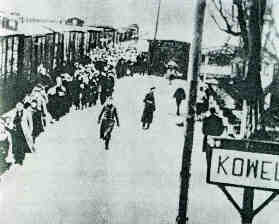
Thousands of trainloads of Ukrainian Ostarbeiter were sent to Germany for slave labor from cities like Kovel, Volhynia, Ukraine in 1942.
For example, on September 3, 1942 Hitler demanded that half a million Ukrainian women be brought to Germany to free German women from housekeeping. Hitler thought there was a Germanic strain in Ukraine because the Ostro-Goths and Visi-Goths had lived in southern Ukraine 1,800 years earlier and the "chaste peasant virtues of Ukrainian women" appealed to him. In the end only about 15,000 girls were taken to Germany to work as domestics. The other two million Ukrainians worked mostly in the armaments factories including the V-2 rocket factory at Peenemunde.
At the end of the war some 120,000 Ukrainians registered themselves as displaced persons (DPs). Most Ukrainians who survived the war in Germany were forcibly repatriated to the USSR because of the Yalta agreement. Repatriation almost always meant death or exile in Siberia.
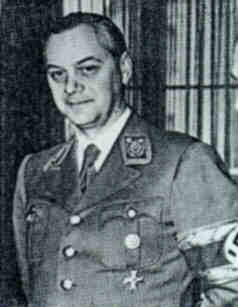
Alfred Rosenberg
1893-1946
Photo courtesy of R. James Bender.
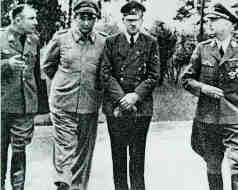
Nazi German leaders Martin Bormann (left), Hermann Goering, Adolf Hitler and Himmler on July 20, 1944.
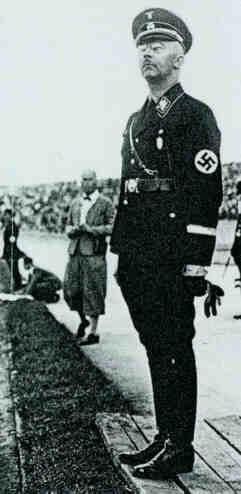
SS Leader Heinrich Himmler said "the entire Ukrainian intelligentsia must be decimated".
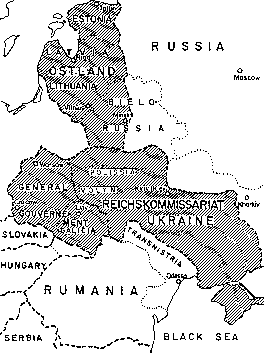
Political boundaries of Ukraine under German occupation. Hitler ordered partition of Ukraine into five pieces to destroy it: 1) Western Ukraine (and Poland) in the General Government, 2) Reichskomissariat Ukraine central Ukraine, 3) Eastern Ukraine with Kharkiv was under German Army zone of administration, 4) Southern Ukraine with Odessa was renamed Transnistria and put under Romanian occupation, 5) Hungary occupied Carpatho-Ukraine. Map courtesy Petro Sodol.